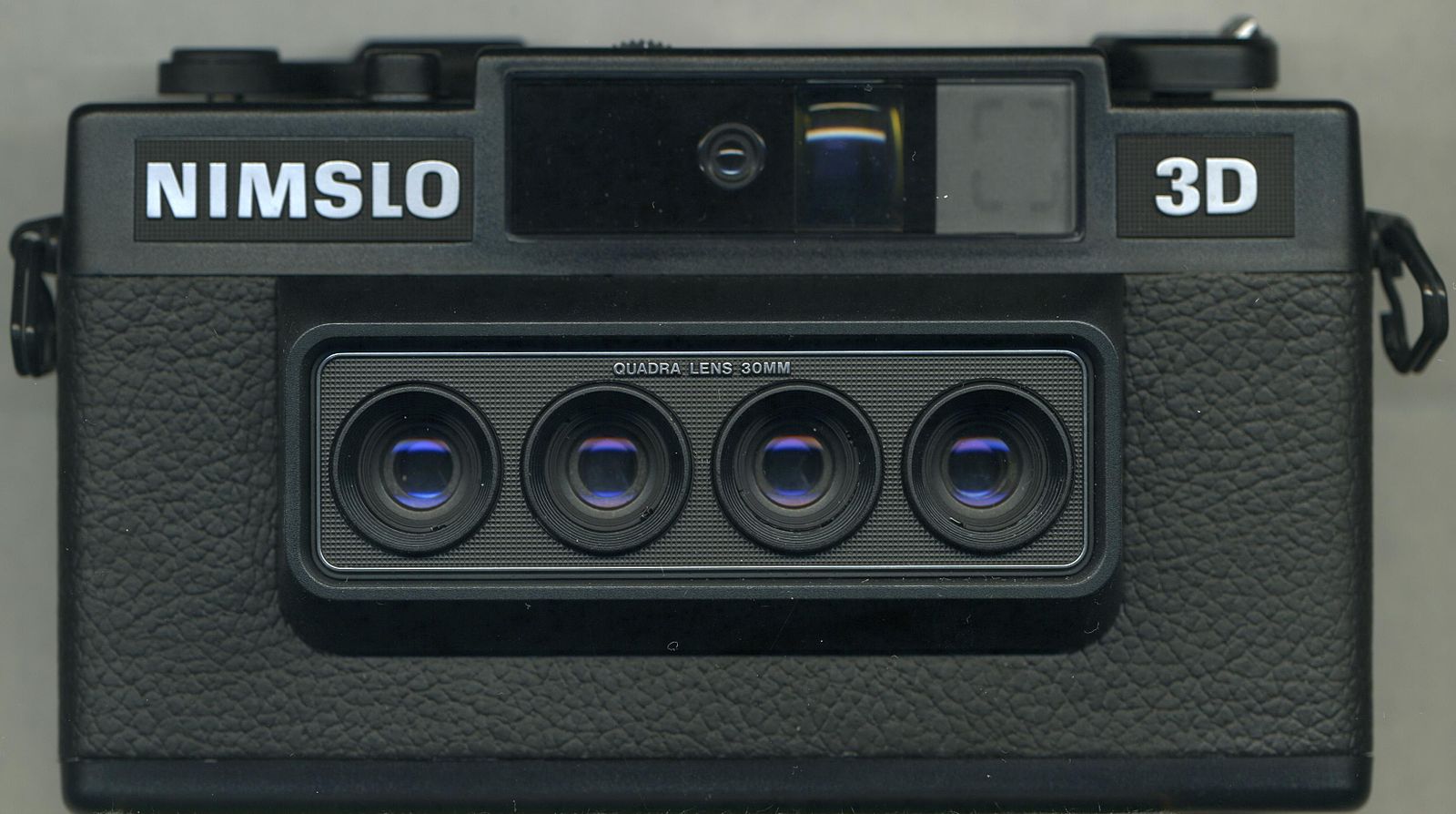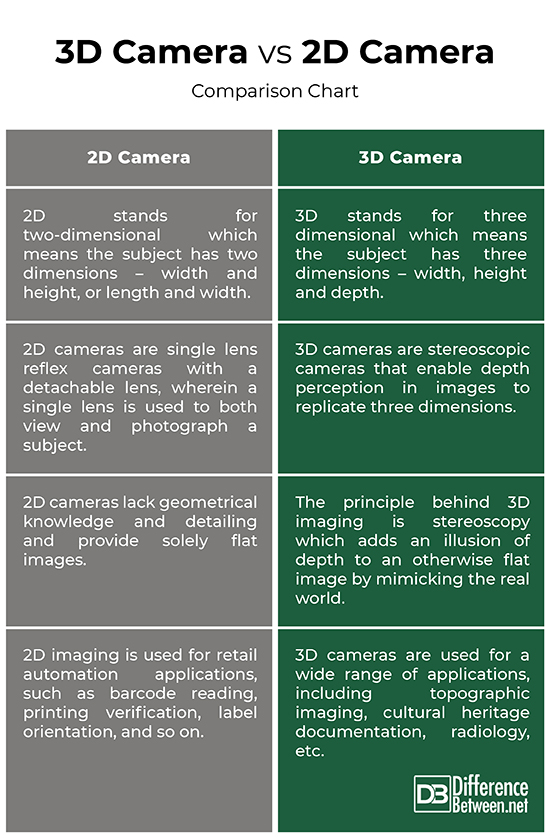Difference Between 3D and 2D Camera
Cameras, or in more general sense photography, are now a staple of the modern society, and for years, we have been using these devices to document every aspect of our lives. The use of cameras in science has a long history in fields such as astronomy and medicine. Surprisingly, the advances in photography and camera have found their way into the conservation arena, and over the years, become a preferred tool for wildlife photography. Looking a few years back, cameras were a luxury back then and digital cameras were totally unheard of. And today, we carry all things digital. Now, we have digital cameras that help us capture life-like images and save them in digital formats on our PCs and CDs. In the last decade, 3D imaging found increased acceptance and application, which was largely driven by the development of 3D digital cameras. Today, digital cameras are at the forefront of the modern-day digital convergence.

What is a 2D Camera?
A 2D camera is a standard camera with single lens. Every camera that is not specifically 3D is two-dimensional wherein it creates an image in two dimensions – width and height. 2D cameras are more like fixed-focus cameras with non-adjustable lens that only focuses sharply at a particular distance. They have wide angle lenses and small apertures, so they are only used for taking pictures in ordinary daylight. Because the lens does not collect a good amount of light, they cannot be used in low light. 2D cameras are single lens reflex cameras with a detachable lens, wherein a single lens is used to both view and photograph a subject. They provide automatic, semi-automatic, or manual control over shutter speed, aperture and focus. This makes them ideal for recreational photography.

What is a 3D Camera?
Traditional 2D cameras lack geometrical knowledge and detailing, and they provide solely flat images. Three-dimensional (3D) digital cameras have finally tackled the issue of depth estimation by carefully coupling hardware and software. 3D cameras enable depth perception in images to replicate three dimensions – width, height and depth. They use multiple lenses to capture multiple points of view, generating life-like 3D models from image sequences, which have a wide range of applications. The principle behind 3D imaging is “stereoscopy”. Well, the 3D content capturing process is different with different types of cameras. A stereo camera simultaneously captures video and associated per-pixel depth or disparity information; multi-view camera captures multiple images simultaneously from different angles. Then the disparity map for each pair of cameras is generated using a multi-view matching process, from which the 3D structure can be estimated.
Difference between 3D and 2D Camera
Imaging
– The term 2D stands for two-dimensional, whereas 3D stands for three-dimensional. 2D cameras are single lens reflex cameras with a detachable lens, wherein a single lens is used to both view and photograph a subject. Two-dimensional imaging refers to a subject that has two dimensions – width and height, or length and width. 2D cameras lack geometrical knowledge and detailing, and they provide solely flat images. 3D cameras, on the other hand, enable depth perception in images to replicate three dimensions – width, height and depth – which resemble the way we see them through our own eyes.
Technology
– In 2D imaging, the x-axis represents width and the y-axis represents depth, whereas in 3D, height is represented by the z-axis. The principle behind 3D imaging is 3D parallax and stereoscopy. Stereoscopic imaging is a technique used to create a 3D effect, adding an illusion of depth to an otherwise flat image thereby mimicking the real world. Stereoscopic imaging either uses a pair of cameras placed at different angles to capture photos or a single moving camera to capture photos at different times. Multiple images taken simultaneously using multiple cameras are collectively called a stereoscopic camera or a 3D camera.
3D Camera vs. 2D Camera: Comparison Chart

Summary of 3D Camera vs. 2D Camera
Every camera that is not specifically 3D is two-dimensional wherein it creates an image in two dimensions, whereas 3D cameras are based on the principle of stereoscopy which is a technique to create three-dimensional effects, which add an illusion of depth to an otherwise flat image by mimicking the real world. 3D cameras enable depth perception in images to replicate three-dimensional effect which resembles the way we see them through our own eyes. 2D imaging, on the other hand, lacks geometrical knowledge and provides solely flat images. Over time, 3D imaging has found increased acceptance and application in the real world.
- Difference Between Caucus and Primary - June 18, 2024
- Difference Between PPO and POS - May 30, 2024
- Difference Between RFID and NFC - May 28, 2024
Search DifferenceBetween.net :
Leave a Response
References :
[0]Langmann, Benjamin. Wide Area 2D/3D Imaging: Development, Analysis and Applications. Berlin, Germany: Springer, 2014. Print
[1]Giancola, Silvio et al. A Survey on 3D Cameras: Metrological Comparison of Time-of-Flight, Structured-Light and Active Stereoscopy Technologies. Berlin, Germany: Springer, 2018. Print
[2]Richardson, Martin. Techniques and Principles in Three-Dimensional Imaging: An Introductory Approach. Hershey, Pennsylvania: IGI Global, 2013. Print
[3]Su, Guan-Ming, et al. 3D Visual Communications. Hoboken, New Jersey: John Wiley & Sons, 2012. Print
[4]Pears, Nick et al. 3D Imaging, Analysis and Applications. Berlin, Germany: Springer, 2012. Print
[5]Image credit: https://commons.wikimedia.org/wiki/File:Nimslonew.jpg
[6]Image credit: https://storage.needpix.com/rsynced_images/camera-1264410_1280.jpg
